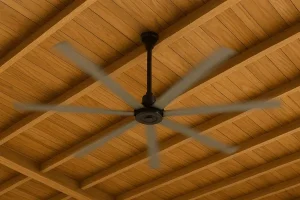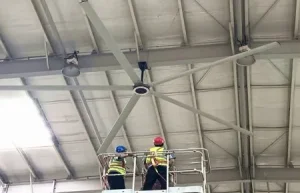Factories, sports arenas, and espaços industriais often battle intense heat and poor air circulation. This issue disrupts workflow, inflates cooling costs, and makes employees or visitors uncomfortable. Fortunately, a dependable ventilador industrial can transform these environments—offering consistent ventilação, reducing energy usage, and creating a safer, more productive place to work and thrive.
Yes, there are different types of industrial fans designed to move air efficiently in configurações industriais. They include ventilador axial models for high fluxo de ar needs, ventilador centrífugo systems for greater pressão estática, and hybrid designs tailored to unique manufacturing processes. Each type of industrial unit excels at transferring or removing ar quente, dust, fumes, and more. By selecting the right ventilador industrial, you enhance comfort, ventilação, and cost-effectiveness throughout your entire facility.

selecionando o ventilador industrial certo
Um ventilador industrial is a heavy-duty piece of equipment engineered to mover ar in large or complex spaces such as factories, warehouses, espaço industrial, and commercial facilities. Unlike smaller ventilador elétrico units intended for home use, ventiladores industriais are typically made with stronger materials and robust motor components that can endure long hours of operation.
In many industries, dust, fumes, heat, and humidity can make working areas stifling or even hazardous. Industrial fans are essential because they ensure reliable fluxo de ar, reduce discomfort, and support health standards in manufacturing lines or large storerooms. Whether you need a high volume de ar or high pressão estática, a direita tipo de ventilador can keep your workplace functional and safe.
Many production sites rely on fans to create consistent movimento do ar, carry away ar quente, or simply ventilation system improvements. This synergy keeps machines cooler, helps employees stay comfortable, and ensures better air quality for everyone on-site. That’s why companies in multiple sectors invest in ventilador industrial solutions—to optimize processes, protect equipment, and maintain higher morale among employees.
Types of industrial fans can vary in design, capacity, and intended usage. But generally speaking, they fall into two fundamental categories: axial e centrífuga. There are also subcategories that combine or modify these basic principles for specialized tasks.
Cada design de ventilador suits particular environments, temperature demands, or fluxo de ar requirements. For instance, an ventilador axial might excel at delivering a grande volume de ar with minimal resistance, whereas a centrifugal industrial approach thrives on higher pressure, dust-laden air, or specialized tasks like forced drying. Understanding these distinctions helps in industrial fan selection so you can find the perfect match for your site’s unique conditions.
Um ventilador axial aligns the direction of fluxo de ar with its rotational axis. Air enters and exits the fan nearly in a straight line, harnessing the rotating pás do ventilador to propel fluxo de ar forward. Because they handle a grande volume de ar at lower pressure, they’re the go-to choice for broad ventilação tarefas. Axial fan moves air quickly without building up significant pressão estática.
Also called industrial blowers, centrifugal fans handle air into the fan at the center, then spin it outward using rotating impeller or rotor blades. This approach can produce alta pressão or handle dust-laden air with ease. Centrifugal fans are designed to cope with more challenging conditions than many axial systems can.
(Mini Table: Axial vs. Centrifugal)
| Recurso | Ventilador Axial | Ventilador centrífugo |
|---|---|---|
| Airflow Direction | Straight line, parallel to axis | 90° redirection via centrifugal force |
| Pressure Capability | Lower static pressure | Higher pressure potential |
| Main Benefit | Moves big volumes at low pressure | Excellent for dust or high pressure |
| Common Use | Basic cooling, large open areas | Ducted systems, exhaust, dusty air |
In any facility—be it a armazém, production plant, or school gym—ventilação is vital. Without proper airflow, heat accumulates, air quality dips, and employees or patrons face discomfort. An ventilador industrial steps in to push stale air out, bring clean air in, and maintain a stable climate. Over time, better-ventilated spaces see fewer issues with condensation, mold, or stuffy working conditions.
Modern manufacturing setups often require specialized solutions. For instance, a ventilador might push air through ducts or remove fumes from a welding station, while a large overhead axial flow fan can recirculate the entire workshop’s air. Because these fans keep the environment more balanced, you reduce the risk of hot corners or pockets of stale air. This synergy fosters safer working conditions and higher morale.
A complete ventilation system might include multiple units—exaustor for removing contaminants, overhead ventiladores industriais for general air distribution, and ventilador units for targeted tasks. By combining these approaches, managers ensure that every corner of the building receives adequate fresh air, helping employees remain alert and comfortable.
UM ventilador is essentially a ventilador centrífugo that channels air into a narrower stream. Sometimes called “centrifugal blowers,” these devices specialize in generating higher pressure than standard axial variants, making them essential in processes that call for forced drafts, forced drying, or localized vacuum tasks. Blowers are designed to handle anything from clean air to dusty or moist conditions, depending on their exact specifications.
Selecting an industrial fan demands balancing multiple variables—your facility’s size, fluxo de ar requirements, particulate levels, noise tolerance, and eficiência energética considerations. By pinpointing these criteria, you’ll narrow down whether an ventilador axial, um ventilador centrífugo, or a specialized ventilador best suits your needs.
Finally, ensure the fan can handle your workplace environment—be it high temperatures, corrosive substances, or abrasive dust. The “ventilador correto” typically includes coatings, sealed consequência elements, or an industrial fan design that stands up to daily challenges.

Industrial Fan Selection
Um axial flow fan is known for pushing or pulling um grande volume de ar along its axis, typically with minimal mechanical friction or added complexity. This design is key when you want to mover ar in large, open buildings, like massive cafeterias, multi-sport arenas, or distribution centers. The output can be enormous in terms of cubic feet per minute, delivering robust coverage with lower power consumption than some other fan types.
Within the axial category, propeller fans excel at simpler tasks, such as moving moderate amounts of air with limited pressure. Meanwhile, tube fans can handle duct connections and maintain good throughput. If your facility is open-concept with minimal ducting, an axial solution is often the most direct approach, especially if minimal pressão estática is required.
It’s not just about volume. The best axial solutions incorporate advanced lâmina shapes, enabling improved fluxo de ar with minimal power. By selecting a well-crafted ventilador axial with an appropriate design de ventilador, you often get an efficient, quiet system that ensures consistent movimento do ar over large floor areas.
Within the ventilador centrífugo family, backward curved fans feature blades that curve opposite the rotation direction. This geometry fosters higher efficiency at medium to alta pressão, making them ideal for large-scale ventilation or scenarios with dust or moderate particulate. The fan wheel is shaped to reduce aerodynamic drag, meaning quieter operation and stable performance under varying loads.
(Table: Backward Curved vs. Forward Curved)
| Recurso | Backward Curved | Forward Curved |
|---|---|---|
| Blade Orientation | Opposite to rotation direction | Same direction as rotation |
| Uso | Larger industrial ventilation, moderate dust | HVAC, smaller duct systems, less dust/pressure |
| Nível de ruído | Often lower due to stable airflow | Potentially higher at bigger volumes |
| Eficiência | High under variable loads | Good at lower loads, not as robust for large industrial tasks |
Yes. Because industrial facilities vary widely—food processing plants, chemical labs, automotive lines, ventilador de armazém industrial usage—different fan types must accommodate each scenario. For instance, a steel mill might rely on high-temperature fans, while a grain silo requires specialized dust-protected blowers.
Industrial fans are typically modular in design, letting you pick from an array of pás do ventilador, motor sizes, or mounting options. This adaptability means you can choose smaller fans for localized tasks or a large overhead system for generalized climate control. Many times, managers combine multiple solutions—exaustor near specific production lines plus overhead HVLS fans for overall occupant comfort.
High Volume Low Speed fans can be essential for industrial cooling in big factories or school gyms. They mover grandes volumes de ar at a slower rotation, ensuring uniform distribution. Meanwhile, if you need to channel air through a labyrinth of ducts or high humidity, a specialized ventilador might be the better pick. Understanding your facility’s exact demands is the key to effective ventilador industrial uso.
(Citar)
“When we replaced multiple pedestal fans with one HVLS overhead unit, the difference in worker comfort was striking,” reports a manager from an automotive assembly plant.
We see it time and again—ventiladores industriais can do more than just stir up air. They can mover grandes quantidades de ar in a controlled, effective manner. By choosing the correct design de ventilador, you address your building’s shape, production lines, occupant density, or other unique factors. The payoff? A comfortable workplace, improved morale, and an overall synergy between ventilation, safety, and cost control.

Aplicação de ventiladores em grandes edifícios comerciais
How do I choose the right fan for my industrial facility?
First, identify your fluxo de ar needs, pressão estática requirements, and environment conditions. Then match them to an axial ou centrífuga model. If in doubt, consult HVLS Fans Manufacturing, as we’ll analyze your building size, dust levels, and temperature demands to recommend an optimal solution.
Can industrial fans also handle dust or chemical fumes?
Sim. Muitos ventiladores industriais—especially certain ventilador variants—are built to manage dust-laden air or moderate chemical presence. If you face heavy contaminants, a specialized approach with protective coatings or dustproof seals may be necessary.
Is a large industrial fan always better than multiple smaller fans?
It depends on your layout. One grande ventilador industrial or HVLS device can provide broad coverage, but partitioned spaces might require multiple targeted fans. Similarly, if certain areas need intense spot-cooling, a smaller approach might suffice.
Do I need to worry about vibrations in industrial fan setups?
With correct mounting, a stable carcaça do ventilador, and the right fan wheel, vibrations can stay minimal. Checking alignment, balancing pás do ventilador, and ensuring you have the correct design de ventilador helps keep vibrations in check. Over time, routine inspections keep your system in top shape.
Which industries typically use industrial fans?
Numerous sectors—food processing, automotive, warehousing, electronics, agriculture, and more. Any environment that requires better ventilação, temperature regulation, or dust control stands to benefit from specialized ventiladores industriais.
Ultimately, the correct ventilador industrial solution can truly optimize your industrial cooling, ventilação, and overall performance. At HVLS Fans Manufacturing, we help fábricas, edifícios comerciais, centros esportivos, academias, escolas, armazéns, e instalações de fabricação find fans that fit their unique processes. Whether you’re handling dusty processes, searching for an ventilador axial para mover ar swiftly across a giant warehouse, or in need of a ventilador centrífugo to handle heavier pressures, our engineering expertise ensures you choose the right fan for your environment. Eager to enhance movimento do ar and reduce operating costs? Reach out now to discover how specialized fans from HVLS Fans Manufacturing can revolutionize your facility, delivering comfortable, efficient, and safe conditions all year round.

Olá, eu sou Michael Danielsson, CEO da Vindus Fans, com mais de 15 anos de experiência na indústria de engenharia e design. Estou aqui para compartilhar o que aprendi. Se você tiver alguma dúvida, sinta-se à vontade para entrar em contato comigo a qualquer momento. Vamos crescer juntos!